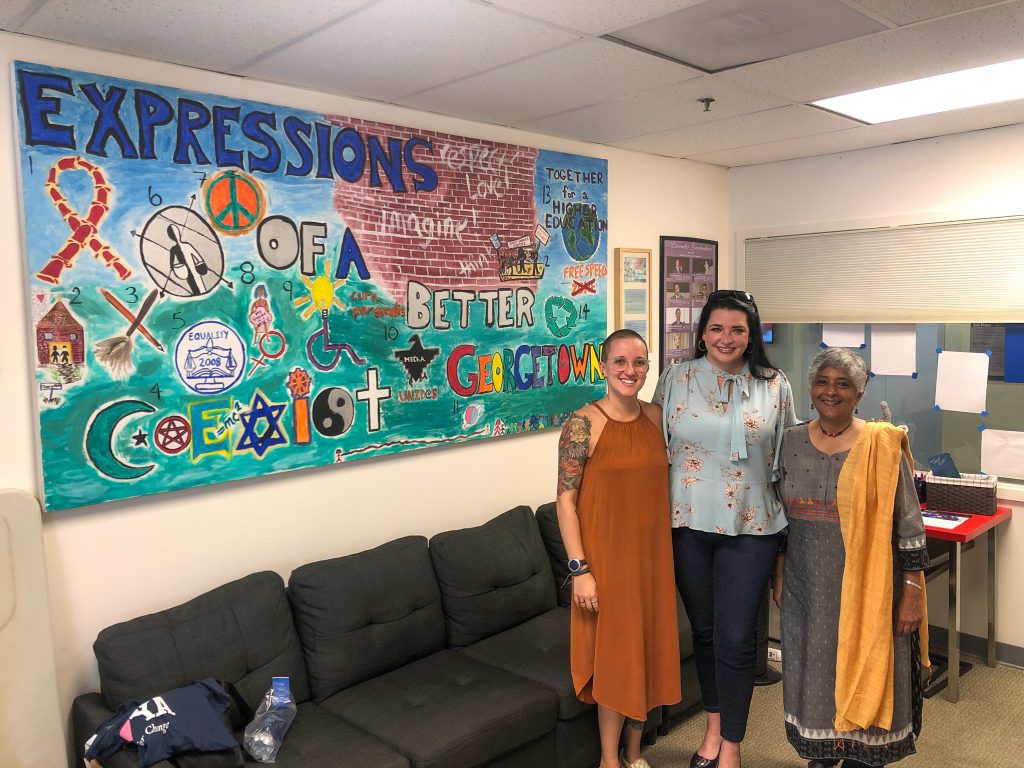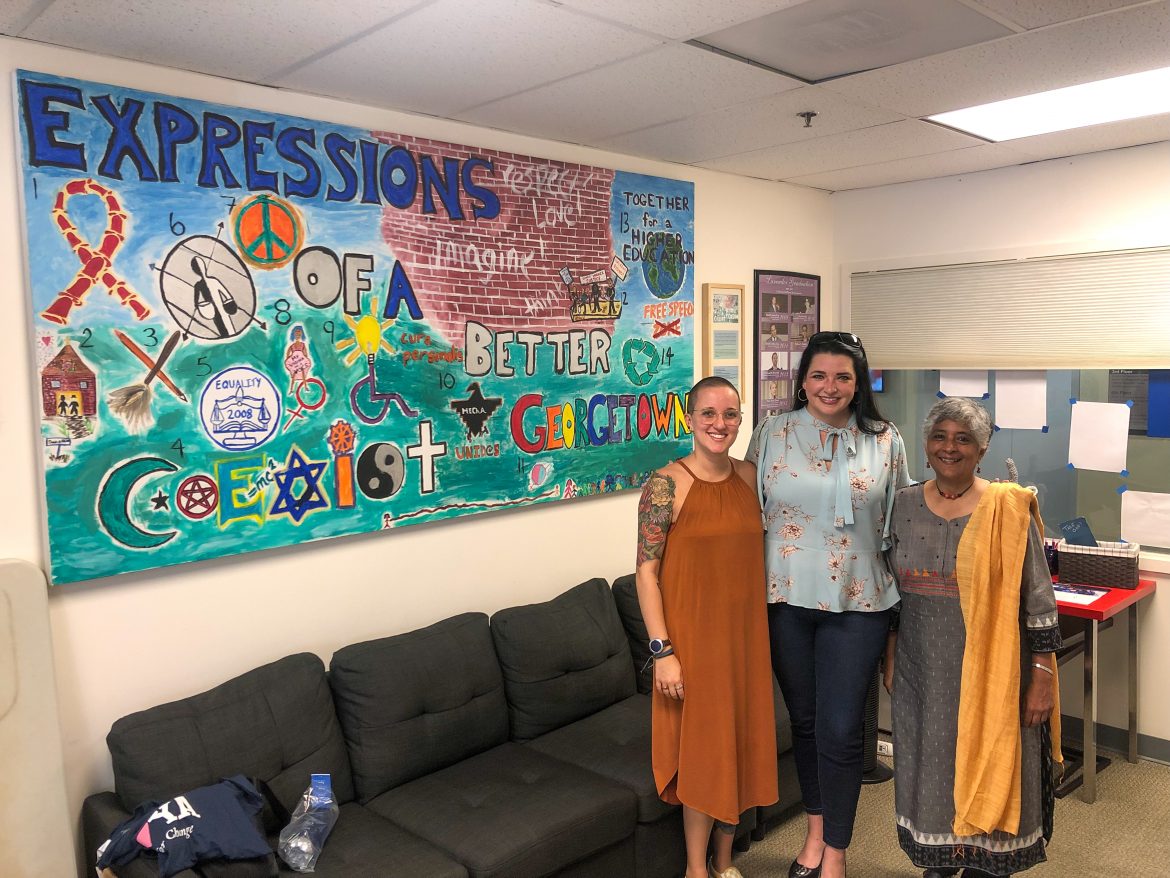Disclosure: This post is Sponsored by Salesforce.org
I went to Georgetown University to look at how the university is reimagining the future of education and leveraging Salesforce.org Education Cloud to do so. This is one of those stories of transformational impact.
As I sat waiting for Lavender Graduation to begin, I couldn’t help but notice Sivagami (Shiva) Subbaraman, a beautiful ball of energy floating around the room. Her smile was contagious and her arms welcoming as she hugged every person she came in contact with. Shiva is the Director of the LGBTQ Resource Center at Georgetown University, which is one of the first institutionally-supported LGBTQ centers in a Catholic and Jesuit university in the country.

Lavender Graduation is not unique to Georgetown; this ceremony was founded by Dr. Ronni Sanlo in 1995 to celebrate and honor the achievements of LGBTQ students, and to bring visibility to the community. It was clear the love the attendees had for Shiva. It was her mission to make the students’ time at Georgetown memorable and special, all while celebrating their accomplishments. I definitely grasped the sense of what Shiva calls ‘chosen family’ as I looked around the room.
I think often times, especially across social media, it’s perceived that many religions are not that accepting of the LGBTQ community. Yet, here Shiva is, a queer, Hindu immigrant woman running this center at a major university. Talk about all of the boundaries she is pushing not only in society but at a Catholic and Jesuit University!
Shiva is certainly no stranger to the importance of diversity and inclusion so I was thrilled that she took the time to speak with me about how she ended up at Georgetown and what it means to be a Hoya*.

What inspired you to follow a career path in the field of Education?
Growing up in India in the 60s meant a deep awareness of the transformative potential of education, particularly in relation to social inequities for those in marginalized populations, and particularly for women, as a way towards empowerment and change. I was most deeply inspired by the many women in my family, who in far harder times in the early 1900s had fought to be educated, and had been teachers. For me, education has been enduringly about not teaching, but learning. My career path within education itself has been circuitous, challenging, and ultimately, deeply fulfilling. The concept of “guru” (more than the English equivalent of teacher) is a foundational piece of how I think about education, even as so many of its values, and its dharmas, seem to be eroding or questioned. The path of knowledge is a deeply revered path, and it has sustained.
What brought you to Georgetown University?
Destiny. I say this in all seriousness. I was working at a different institution, and was not looking. I met a young person at a conference who was in my workshop, and said that they were setting up a center at Georgetown. We were all wide-eyed, given that it was a Catholic institution. They said I should apply, but I said I was neither “a fool,” or “that brave, “and in any case, I assumed it would be important for me to be Catholic. A few weeks later, and just two days before applications closed, I applied; things had changed at my home institution, and it seemed it was important for me to move on.
My visit to campus was transformative for many reasons: at the heart of it were the students, those who had fought long and hard for their right and need to be seen. And particularly in a Jesuit context, to be seen is profoundly rooted in a long tradition of moral theology, of education, and of social justice. Second, it was patently clear that the University had done the kind of soul searching that rarely happens, and they were primed and ready for the change they wanted.
And finally, a Jesuit, asked me why I would want this job that would be so challenging, probably uphill, and quite frustrating. I did not really need to think about that, and I said, “because succeed or fail, I will learn and grow.” And I knew that in my bones: it was a historic opportunity to be the founding Director, but what spoke to me the most was that here, I would learn and grow. I heard later, that that was what got me the job!
In many ways, these past 11 years have been more than a job or work; it has truly been “a calling,” especially as the work has evolved, and the opportunity to work at the intersection of sexuality and faith (multi-faith, I might add) has been an enormous privilege. In a way, this has also allowed me to return to my roots: I am a product of the Catholic educational system in India—all through high school and University; and in a colonial context, that system was, like much else, a mixed braid of a blessing. So, in a deeply personal way, this has brought my life back full circle.
The Georgetown University LGBTQ Resource Center is one of the first of its kind in a Jesuit University in the country. This proves GU is pushing traditional boundaries. How else has the University evolved since you arrived?
Georgetown has had a long history of thinking, and re-thinking its own evolving identity and goals, within the context of its religious identity and mission. They do try to fully live out the Jesuit understanding of “creative tensions,” and have done so around very difficult issues: LGBTQ being one of them. Placed within this context, I would say it is not a contradiction at all that we should be here; in fact, as Fr Howard Gray, Special Assistant to the President, and former interim VP of Mission & Ministry, would often phrase it, “we do this not despite, but because we are Jesuit.”
I like to imagine this creative space as being between the purity of the Jesuit ideals, and the reality of lines in the sand, and knowing how to embrace the paradoxical as an inherent value. I have learned too, that sometimes change happens when we “align,” what others may see as contra –when we align our work to the mission, and that alignment in and of itself is the radical shift.
We think there has been a significant shift on campus across its entire breadth and depth: from admissions to alumni relations, we work with the range of institutional endeavors. Most important, we have made the work an integral and integrated piece of the Georgetown Hoya, and that has allowed it to flourish and to thrive. Student leaders who were organizing the Out for Change campaign that brought the Center into existence painted a beautiful mural with the slogan, “Expressions of a Better Georgetown.” In many ways that captures the essence of the change that they envisioned and that has subsequently happened on campus.

I had the honor of attending Lavender Graduation while on campus. Can you please share about this beautiful celebration?
While Lavender Graduation is not unique to Georgetown, in many campuses, it is held during Commencement, along with other Multicultural Graduation ceremonies.
What I observed during the many years I did this work prior to GU was the distinctly conflicted, and often painful moment that graduation was for many students. Many of their families, unlike other racially based identity groups for example, did not join in the celebration, and in fact, did not think it was anything to be proud of, even if they were “accepting” of their child. Many institutions do not always recognize the barriers many LGBTQIA+ students face, and that their obstacles and struggles often go unseen and unknown.
What has made the event a departure on this campus has been several things.
It was also deeply important to me that our students be celebrated, be seen, and that the idea of “chosen family,” so important to this community can be brought to this ceremony. Over time, therefore, we have grown our guests who come to this event: from the President of the University, to all the Deans, Vice Presidents, Provost, many many faculty and staff, and other students, they all come together to make this event truly memorable and special.
We started this the very first year of the Center; and over time it has grown from a ceremony that had about 25 students participating to close to 150.
From its inception it was important to me to that this event be the culmination of a student’s journey on campus, AND to be a marker on the very long arc of the Institution’s own journey towards healing and reconciliation. For most of its history, Georgetown was a difficult, painful, and sometimes destructive space for LGBTQIA+ Hoyas. Unlike other Hoyas who felt an enormous connection to their alma mater, I learned that many LGBTQIA+ alums were dis-enfranchised, angry, or at best indifferent to the institution. It occurred to me then that this would be the best way to honor them: to bring many of them back as our Keynote speakers, and so over the last 11 years, we have always hosted an alum as our keynote speaker. This has been emotionally and symbolically powerful: it is a way for Hoyas to reclaim their own histories. It is in this sense then that I deeply feel that Lavender Graduation is not only about our present, but most about our past and our future.
In this important role, you’ve had the opportunity to meet inspiring individuals and participate in life changing programs with your students. I am sure you have many memories along the way. Is there one life changing moment throughout your career that you can share? What or who has inspired you?
This is probably the hardest question to answer. Over the past decade, the best part of this work has been the people I have come to know whose stories of struggle, of joy, of triumph against impossible odds, of despair, of incredible resilience—these are the stories that continue to shape the work of the Center. It is I who have been truly changed and transformed by the many I have met, and who have let me in.
Fr. Howard Gray is the Jesuit who most shaped me. He is a Jesuit legend. Personally, it was a deeply humbling and moving moment when I was invited by the Jesuits to be an eulogist at his Memorial Mass held at Dahlgren Chapel. For a queer, Hindu, immigrant woman that moment embodied all that is best of the creative tensions I spoke about earlier.
Chan and Paul Tagliabue (former Chairman, Board of Directors, GU, and former NFL Commissioner). They gave us an unprecedented one million dollar endowment in 2011 in recognition of the enormity of leadership and courage that Georgetown had taken in establishing the Center. .
And last but not least our students who continue to inspire, to aggravate, to challenge, to share, to fail, to find their voices…it is their dreams and aspirations and their sharings that keep us deeply embedded in this work. It is knowing the student who made it past their diagnosis of HIV; the student who attempted suicide, but who began to see they were loved, and went on to find joy and meaning; to the student who brought questions at every turn….they have truly made me understand that being LGBTQIA+ is not just about coming out, but a coming together of all of who we are, and who we can be and become.
* Many years ago, when all Georgetown students were required to study Greek and Latin, the University’s teams were nicknamed “The Stonewalls.” It is suggested that a student using Greek and Latin terms, started the cheer “Hoya Saxa!”, which translates into “What Rocks! The name proved popular and the term “Hoyas” was eventually adopted for all Georgetown teams.

